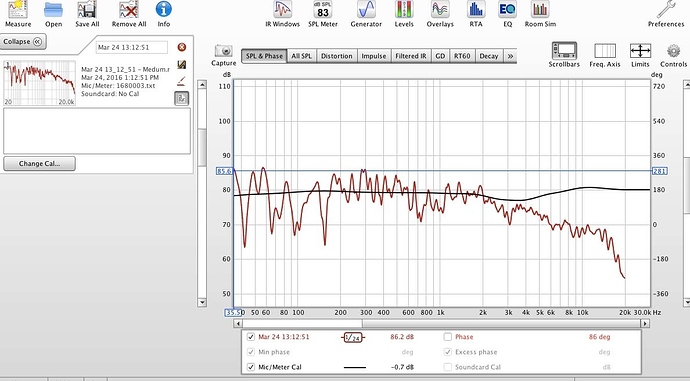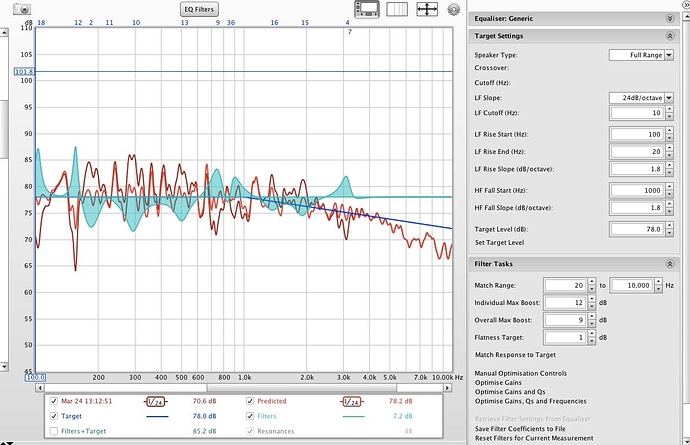Continuing the discussion from HQPlayer / Roon Integration: Ready for Prime Time?:
Hi Hammer,
You may have been asking a rhetorical question, but I understand that people who have implemented real time room EQ correction are almost universally of the view that it was the best audio “bang for buck” improvement to their system.
HQP supports room EQ with a convolution engine and, in true Jussi style, filters can be generated using free software such as Room EQ Wizard. I plan to experiment with room EQ after 1.2 is released and will probably bore you all with a post about my adventures when I do.
There is a CPU load to room EQ. I expect that upsampling Redbook to DSD 256 using closed form filter and ASDM7 while applying real time room EQ and running RoonServer on the same machine would all require a good powerful i7 CPU.
If your PC can comfortably handle closed-form Redbook->DSD256, ADSM7, I won’t be too concerned about Room EQ (assuming 2 to 6 channels and not very long filters).
@andybob, I absolutely agree. I use REW with HQP and the results are truly amazing. I purchased my current system a couple of years ago and it was a huge step up from my prior system and so I was very happy with the sound. Switching from Logitech Media Server to HQP was a huge leap in SQ (even with the same DAC). Then over Christmas break, I found some time to play with REW and now I can’t listen unless I have the filters enabled. The bass is much tighter/less bloated and vocals are much clearer. What is really cool is there is a button in HQP which allows us to enable/disable the filter in realtime so we can A/B the difference - it took me a while to find it, and it’s the green check mark. So, yes, another “bang for the buck” improvement thanks to HQP and why I am such a loyal fan.
As an aside, I also found adding a CUDA card is a cheap way to repurpose an older pc which is not powerful enough to support HQP on its own. I went all out and got a GTX980, but at DSD128/ADSM7/Convolution, the CUDA load is only 20%-25% max, so perhaps a 960 will also do the job. My Auralic Vega can only do DSD128 so I don’t know about DSD256.
Happy to share experiences (although I am no expert in REW). What I did find, after some googling, is that using a usb mic greatly simplifies the process. I went that route and used a calibrated MiniDSP UMIK-1 and it worked very well for me.
I’d say try it now and don’t wait until 1.2!
Waiting for 1.2 is more a question of available time rather than any functionality. Looking forward to playing with it. I read some of the materials regarding REW and it looked as if the test files had to be played through REW rather than through Roon/HQP. Does that sound right ? I think there’s a tonal difference between the sound I get from my PC System Out and Roon/HQP.
Although I see room correction as the “next frontier” I worry that we will lose some of the benefits that we today are getting through HQPlayer (especially if you are upsampling to DSD256 or the like). As far as I know, all the correction software requires limiting yourself to 24/96 or 24/192PCM output. Perhaps there is a way to do the correction before the music gets to HQPlayer such that you can still upsample to DSD256, just after the room correction software does its thing (which would then just not allow you to use DSD or DXD as starting source material).
In addition to REW it is also worth considering Dirac, which isn’t cheap, but attempts to correct both frequency response and impulse response.
HQP has a convolution engine itself. So once you have generated a room filter using REW or some other room EQ program, you load it into HQP and upsample and convolve together at any output rate supported by HQP. This is what I understand @hammer is doing.
Advantage of running the GPU on lower load is less noise from the GPU cooling fans, because the thermal design is rated for full power…
I thought I would give the convolution engine a try after reading the post. I used a Dayton UMM-6 USB microphone and REW to generate the WAV files. The software recognized the mic and loaded the calibration file, so I didn’t have to do much. Below is the room response and then the EQ/filters.
I haven’t done any comparison between the convolution engine being enabled or disabled, so I can’t comment on any improvements. It was interesting to play around with the software, see the room response, and how the corrections are made. I used most of the default target settings on REW and a generic eq.
If anyone has any feedback on what you see in the graphs, please comment. I’m assuming I did everything right…
That’s very interesting Erik, thanks for posting. I don’t know enough to make a comment but have some questions for you and @hammer , if you would pardon my inquisitiveness:
What shape and (rough) dimensions is your room ? What sort of furnishing, carpet, wall coverings ? Any room treatments ?
What type of speakers ?
What were your thoughts about your system before you measured it, were the graphs consistent with expectations or something of a surprise ?
If you’ve had a chance now to listen to engine on/off, how do they compare (have seen @hammer’s comment above).
Please forgive me if you already know this.
When you try to EQ for your room based on your listening position, it is better to do some kind of spatial averaging so that the EQ works when you move slightly away. You may get better results by making multiple measurements (imagine a 3D box and 8 corners and at the center) then using the average of those measurements for the EQ.
My initial observations on REW using an un-calibrated Radio Shack SPL:
- REW showed the holes we suspected were there in the sound
- Even a very smooth room EQ applied as a convolution in HQP produced interesting results but not something I’d want enabled
I think we the right hardware i.e., properly calibrated mic / SPL, and time spent in REW, a nice room EQ could be achieved.
I really enjoy the HQP integration with Roon - nice fit. There are some quirks, but certainly manageable. My use of HQP is for some very light lifting - mostly up-sampling redbook to 176KHz. I let my Meitner do the rest of the up-sampling as it does a superb job on its own.
My room is 17x30x10 (WxLxH). I sit about 14 feet from the speakers and that’s where I setup the mic. Furnishings, just living room furniture (i.e. coffee table, couch, etc) and tile floors. I do not have any room treatments.
My speakers are Vapor Audio Sundog’s with a RAAL 70-20XR tweeter and Accuton C158 woofer. I run the speakers with a HSU ULS-15 subwoofer. The cross-over on the speakers was designed, with Ryan from Vapor’s recommendation, to start rolling off below 170Hz and that’s where the sub would take over.
In regards to the expectations, I’m just experimenting for now. But long term, I’m looking to make improvements when I learned more about how to take measurements and use REW. And now that I see the how I had the sub setup, I’m glad that I went through this first exercise.
I haven’t done any comparison’s yet between the engine on/off, because HQP is running on a Debian Virtual Machine in another room. I haven’t taken the time to setup Teamviewer or VNC on that VM yet.
Thanks for the input, actually, I had no idea, but it makes sense. Looking to learn more about this topic,
Some generic recommendations. I usually use 1/12th octave smoothing before running eq filter design in REW. The generated filters don’t look too bad though. With smoothing you are also less likely to end up with high-Q eq filters that usually sound bad.
Note that if you allow +9 dB boost, you need to check the max boost generated for the filters and set gain compensation in HQPlayer accordingly. That will drop the overall level for example by 9 dB, but avoids running to peak limiting when music content happens to contain frequency that hits the boost peak…
Another recommendation is to keep corrections only up to 1 kHz or lower, usually problems are in the bass range. However, do not try to fill up null points with excessive max boost (I’d recommend 6 dB max boost), that won’t be possible but attempting it will have adverse effects.
Coming up with good target curve is essential. Good starting point is straight line from 20 Hz to 20 kHz with about -6 dB drop at 20 kHz vs 20 Hz. One of the commonly referred and popular ones is the B&K house curve:

@jussi_laako thank you kindly for sharing - great suggestions actually. Been using HQPlayer for about 2 weeks now and spent some time a week ago with REW to develop a left and right convolution. These suggestions help tremendously.
Question - how critical is the mic / SPL? I see the miniDSP mic being recommended, but I can’t understand how a USD$75 mic can be accurate enough? I equate REW to calibrating and profiling a computer monitor for colour critical work, whereby a top quality meter is required and can’t be purchased for USD$75.
If you want better control over the EQ (i.e. do it manually) and also correct for the phase, importing the REW measurements into rephase is also a good option, then you can create the filters you need for HQP in rephase (warning, some steep learning ahead  )
)
Looks very interesting - @KMan are you using the UMIK-1 mic for your measurements? Have you tried it?
No, I use something even cheaper (ECM 8000), but I think UMIK-1 should work just fine. With the amount of uncertainty introduced by mic position/direction and room measurement in general, you do not need ultra-pricise expensive microphone as long as you have the calibration file for your mic. You can also check recommendations by Room EQ software vendors such as Dirac and Acourate and REW forum too.
I EQ headphones more than I do Rooms, so there may be other experienced folks here who can chime in. However the process I use to EQ are quite similar and of course I use a different kind of microphone for Headphone and in-ear measurements.
Hi @andybob, I finally got around to the A/B testing. But before doing so I tried to improve the room response by moving my Subwoofer around. I did not have much space to play with, but I moved it up against the wall and to the right about 1 ft. I was able to slightly better the low end dips. I took @jussi_laako EQ advice (thank you by the way) and created new filters.
I wish I had a better way to describe the improvement, but it’s as if everything is neater, tighter if you will. If I were single and could position my speakers and subwoofer anywhere I wanted, I’m sure there’s an optimal position where the recommended 6db max boost would yield a nice smooth curve. Since I don’t have that liberty, the improvement is probably not as good as it could be.

